Warlord Deckbuilding: Counterdraw
/Tired of getting swamped by Elves and Nothrogs? Here be answers!
Read MoreTired of getting swamped by Elves and Nothrogs? Here be answers!
Read More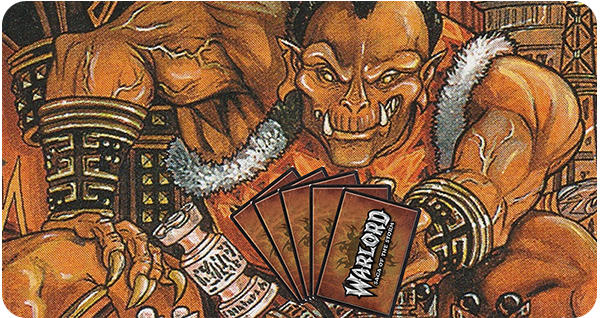
When you sit down to play a game of Warlord, the only cards you are certain to have are your warlord and your starting army. Other than that, you’ll be rolling a 20-sided die and seeing five random cards from your 44 card deck every turn. That’s a lot of random chance to deal with.
Warlord is all about minimizing that randomness: high strike rolls minimize your chance of missing, making a ton of strike rolls increases your chance of hitting, and running card draw increases your chances of seeing the cards you want to see. In this article, we’ll discuss the card draw mechanic in detail—when to use it and what may be the best cards to help you use it.
Card draw is one of the most potent tools in a player’s arsenal: the more cards you see on a given turn, the more options you’ll have and the more likely you’ll find the options you need. So why doesn’t everyone cram their decks full of all the Meet at the Inns and Back Alley Taverns they can find? There are two general reasons why too much card draw can be problematic:
1) Draw takes actions.
2) Draw can be countered.
Draw takes actions. You need to spend your actions to draw cards. Each action you spend adding cards to your hand is an action your opponent can spend changing the board state in their favor. Giving actions to your opponent is problematic for archetypes like rush decks, where you want to strike as quickly as possible, and the longer you give them to prepare, the harder it will be to cut through their defenses. When rush decks play card draw, it will typically be Draw + Effect cards like Carg’rag or From Dust to Dust. For slower decks, who will have fewer options on turn 1, the action cost of draw is not as big of a deal.
Draw can be countered. Cards like Staff of Secrets, Rr’gent and Twist of Fate can turn cards that draw cards into dead cards. No other type of card can be made so completely irrelevant so simply. Furthermore, the more people playing draw, the more likely other people will play draw hate (cards that prevent or interrupt draw), and then the more draw you’re running, the worse it will be for you.
Assuming you’re not playing a combo deck that runs every piece of card draw it can (hello, Dragon’s Hoard!) in an attempt to find your pieces before your opponent can kill you/access their counter draw, you’re going to want to think carefully about how you’re drawing cards. The rest of this article is analysis of some of the most common ways players draw cards in Warlord.
Meet at the Inn – The classic draw card. You pay a card to get two, your opponent gets one for free. Both players end the action with 6 effective cards for the turn, but you have removed an additional card from your deck. This can also be played by any character, allowing you to dodge counters that punish the character drawing, like Baraz or Exhaustion.
When to Run: If the cards in your deck are, on average, better than the cards in your opponent’s deck. You’re giving your opponent something here too, so you must make sure what you’re getting is better. For combo decks, this is generally true: they’re betting their whole game that the opponent’s deck can’t handle a particular set of cards, so the quicker they find them, the better. The same is true for Uber, with the idea that once your Warlord hits a certain power level, your opponent won’t be able to kill them.
When not to Play:
You can literally always play Meet at the Inn. But when should you? There are two chief drawbacks to a Meet: 1) it gives your opponent something else to do and 2) it sits in your hand, taking the place of other cards. Deciding when to play Meet at the Inn is a matter of weighing these two drawbacks. You don’t want your opponent being able to perfectly plan their turn with the 6th card you’ve given them, so it can be good to delay playing Meet as long as possible. You also need to be able to do what you WANT to do: Meet helps you do that when you play it, and hinders you when it sits in your hand. Always consider if you need those two more cards immediately, and how much that one extra card of your opponents’ might hurt you.

Back Alley Tavern – Draw through counter draw! Back Alley Tavern is either a very expensive cantrip (a card that replaces itself when you play it) or a free card and some deck thinning. In your starting army, only your Warlord will be able to play it (barring Lekar Osud plus Yanthorine!), so be careful of Ill-Gotten Gains or Exhaustion.
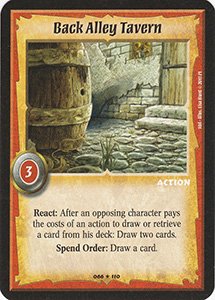
When to Run: there are two reasons to run Back Alley Tavern. The first is that you’re running combo and want to play every cantrip you can. Back Alley Tavern is a Dragon’s Hoard with upside. The second reason is that you think there’s going to be a lot of draw/retrieval in the meta and you want to take advantage. Elves and Nothrog are always drawing, Xod and Adarymy are always drawing, Necromancers must retrieve to play Wheel of Death. Wizards are always retrieving or drawing with Phantasm and From Dust to Dust. They’re getting paid, why shouldn’t you?
When not to Play: if you’re playing against a combo deck and you aren’t running any other draw, playing a Back Alley Tavern may allow them to play their Back Alley Tavern, and their two cards are probably going to be more important than yours. Also, if you can’t trigger the react, it requires spending a high-level character, so be sure you won’t clog up your back ranks.
Loyalty’s Reward – Sir Robert’s favorite action. Two cards for a spent high-level fighter: perfect for fighter Warlords who want to sit in rank 3. It notably also transforms Bokos from a mediocre level 4 into a card draw machine.
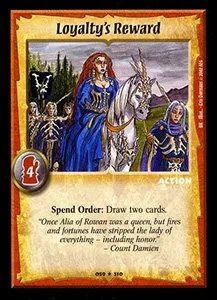
When to Run: you’ve got a fighter Warlord who doesn’t mind hanging back: Sir Robert, Kothkah, Jorn of the Summit, Sir Aleron d’Ilchant. Or you’ve got a bunch of level 4 fighters who can cover for your non-fighter Warlord. If you don’t have a fighter Warlord, you’ll need either a lot of other card draw or a lot of high-level fighter characters to limit the risk that Loyalty’s Reward turns into a dead card.
When not to Play: Loyalty’s Reward can clog up your back ranks like no other. If you’ve got just a Warlord in rank 3 and a level 4 fighter in rank 4, and you use that level 4 fighter to play Loyalty’s Reward, what are you going to do if you draw 2 more level 4 characters? You’ll have to spend your Warlord up to rank 2, severely weakening your defenses. Make sure before you play Loyalty’s Reward you have a plan to play the other cards in your hand.
Extensions – This is Toren Yscar on a stick, with the bonus of letting you send a bad crop of cards to the bottom of the deck. It’s an excellent cantrip card but comes with the high cost of forcing you to spend a level 3 wizard.
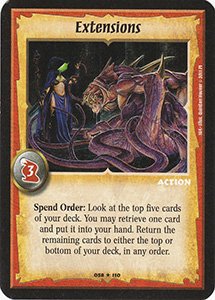
When to Run: if you can start Cal Blackthorne or are Angu Mournwater, this card is worth a look. Otherwise, you must be happy either spending your Warlord for it, or be running several supporting Wizards. Elves and Deverenians frequently run enough supporting Wizards like Caran Tremayne or Cyrus Netheryn to pull it off. Just like Loyalty’s Reward, running off-your-Warlord’s-class draw can be a big risk.
When not to Play: Extensions is strong in its niche, but rarely strong enough to justify a spent Warlord. If you’re playing combo, spending your Warlord for Extensions in a pinch is manageable, since combo’ing off early turn 2 is usually fast enough. But if you see it after turn 1 and don’t have any back up wizards, it will likely be a dead card, or you’ll be too behind on tempo anyways. If you don’t have a character in your starting army who can play it, or a whole bunch of Wizards looking for something to do, look elsewhere for card draw.
Portable Hole – Portable Hole is arguably the best Rogue card ever printed, a non-Steed movement item that turns any item into a cantrip. Rogues like to move, and Rogues like a very particular set of items (Giant Bats, Helms of Fortune, Black Steel Daggers). Portable Hole lets you move and lets you play multiples of your power items so you can cycle the extras. If you’re willing to commit to the draw engine, running Nodwick and Cloak of Many Things and Trade Routes, it can draw you a lot of cards.
When to Run: You need a very good reason not to play Portable Hole if you’re a rogue. It’s a free movement cantrip at the very least. If you’re darting into your opponent’s ranks as quickly as possible, it gets you to the front ran for free, and you’ll be playing other characters who can equip it, like Wanderetch, to hold your ranks while you’re in the enemy formation and unable to. Play Portable Hole.
When not to Play it: if you’ve got a rogue, play Portable Hole. But if you’re up in the front without another way to get back (like Giant Bat), be careful about discarding it, because that’s free movement for the rest of the game you’re sacrificing.
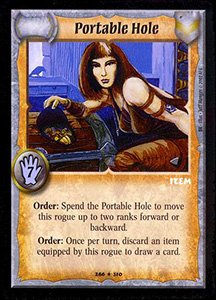
Forewarning – Clerics are a bit short on the draw compared to other classes, but Forewarning is a solid cantrip with upside if you’re a seer, and almost certainly not worth it if you aren’t. It’s similar to another Spend-Order-except-for-Seers, Wheel of Fate, except that you usually want to play Forewarning as quickly as possible, and Wheel of Fate cantrips every card in your hand, so you want to wait until you’ve played everything you want play from your hand.
When to Run: You’re a Seer running a combo deck. You need all the draw you can get, and Forewarning is better than Dragon’s Hoard.
When not to Run: If you aren’t a seer, or if you aren’t playing combo. You’re either playing blitz or control. If you’re playing blitz, an action for a cantrip is a waste of an action most of the time and takes up space in your deck for offense. If you’re playing control, Forewarning takes up space for answers like Litany, Reflect and Exhaustion, that you could need immediately. It also takes up space for niche solution cards, like Peace or Figurine of Protection. The same holds for Wheel of Fate, although Wheel’s ability to draw more cards might make it more appealing.
From Dust to Dust – Probably the most powerful level 1 wizard spell in the game. Even without the ability to conjure up a character from nothing, it’s a spell with a high DC that goes THREE ranks. Your 2nd rankers can hit your opponent’s 2nd rankers. That’s amazing. With the character gain? Insanity. Most wizard spells are aiming to kill an opposing character. You’re trading a non-character card for a character card: that’s good. From Dust to Dust let’s you trade a non-character card for a character card AND get another character of your own. That’s an incredibly high value play.

When to Run: You’ve got wizards with 3 or more skill, and a level 1 character in your deck you wouldn’t mind fetching. In the ideal world, you’re a Nothrog using Yeg-Igryll’s Altar to grab Carg’rag, or an Elf using Skyyrek to snag Kapix. But any free character while killing an opponent’s character is great. If there’s a level one character your deck is centered around, like Ardanaalis, it’s worth considering level 2 wizards to start just so you can run 3 copies of From Dust to Dust.
When not to Play: There are two primary hiccups to pulling off From Dust to Dust. 1) Your opponent has clerics and Reflects you, and now you’re out a key wizard you wanted to protect. 2) Your opponent plays draw hate like Staff of Secrets or Baraz. From Dust to Dust is a draw spell and will be cancelled by Staff and can get its caster sniped by Baraz. If you’re playing vs. a cleric, hold on to that Dust and try to force out a potential Reflect first. If you’re playing vs. a wizard or suspect a Baraz might be coming, play that Dust ASAP. Finally, Dust is the greatest Jackals of Mourn killer in the game. If you suspect a Jackals, consider delaying your Dust.
Drawing cards with characters is almost exclusively better than drawing cards with actions—characters stay on the board and provide additional strikes and additional hit points for your opponent to chew through. In some cases, they’ll also offer repeatable draw. If your opponent is running counter draw, you’ll still have a body out on the field. But the 24 character slots in a typical Warlord deck are hotly contested: it’s characters that equip items and perform actions and it’s characters that win you games: how many of those slots are you willing to give to characters whose main benefit is drawing you more cards? As a thought experiment, I’ve divided the most commonly used card draw characters into 4 tiers, based on how and when you should try to slot them in.

Tier 1: Make Space!
Toren Yscar, Carg’rag, The Lost Bride, Sethusk
These are characters you need a strong reason not include when you’re building a deck. Toren is restricted to 1 copy for a reason. Every deck has cards that are better in certain situations than others. Toren is the easiest way to trade out your cards that aren’t perfect for the situation at hand for your cards that are. Carg’rag and The Lost Bride are our successors to Daedelia—a body for a card. Carg’rag only works on turn 1, but turn 1 is the most important turn in most games, and she’ll also provide a strike. The Lost Bride is similar, but won’t strike for your T1, so could potentially be cut from certain hyper aggressive decks. Sethusk requires an additional action to get that card, but he’s also probably the favorite dish of Nothrog dining tables, so he slots into many of even the most aggressive Throg decks.
Tier 2: Lock Ins for the Right Deck
Llyr Militia, The Devoted, Elemere, Hassimal, Redu Carr, Ramah the Cruel
These guys don’t belong in every deck, but are very strong options when they do. Their draw has a higher cost, but one that’s frequently worth it to pay. Llyr Militia and The Devoted are two of the most stalwart level 1s in the game, providing protection vs multiwounding, level draining, high strikes, and instant-kill effects. Hassimal requires you to spend two characters to draw a card—if you’re trying to draw as much as possible to find your combo, this is amazing! If you aren’t, don’t run him. Elemere, Redu Carr and Ramah the Cruel trade character death for cards—worth it again in combo, and worth it even more if you’re running Necromancers like Feyd Rowan or Azhraan the Foul.
Tier 3: Build Around Them or Ignore
Nelchat the Horror, Revan, Theodore d’Ilchant, Destruction, Flamefang, Knowledge, Limestone Gargoyle, Nepheline Gargoyle, Shame, Vision, Borgen Ferriss, Garth Drac, Harty Tate, Kieran, Alaya, Grihilga, Ivaas (Toren’s less talented little brother), Richard Key, Ga’dok
I won’t break these characters down one-by-one, but there are a couple of reasons a character might be on this list. Maybe they only draw a certain type of card, like Borgen Ferriss or Revan. Cards like this are amazing in decks that want to move their Warlords up as quickly as possible, but useless if you don’t run steed. Others are universally strong, but difficult to get into play, like Nepheline Gargoyle or Garth Drac. You’ll play these cards if your deck allows you to get them out and you want the extra draw, but many decks just won’t have a chance to play them. Finally there are cards whose draw is more costly, or very niche, and requires a huge commitment to draw or a very specific approach to it, like Richard Key or Ga’dok.
Tier 4 Other Reasons: They Draw Too??
Darkness, Eresh q’Shedim, Kel’suk, Rica O’Shea, Shan-Kassyn
If you’re looking for cards with which to draw as much as possible, these typically aren’t the guys you’ll choose (excepting that one infinite Eresh-Duanna deck). These are cards you play to kill your opponent (or help you play other cards that will kill your opponent, for Shan-Kassyn), and they also happen to draw you cards. Don’t play them for the draw—the draw is gravy.
Hopefully this article has given you a solid base to think about card draw in Warlord. How badly do you need those extra cards? What are you willing to sacrifice to get them? What tools best suit your deck, and how and when do you want to play them? And if all this talk has just gotten you excited to shut down your opponent’s attempts to draw, keep your eyes peeled for our next article!
How do you build a competitive Warlord deck? There are probably many many different ways to answer this question. In this article I will provide insights into one deck building method I believe to be quite helpful. Hope you enjoy!
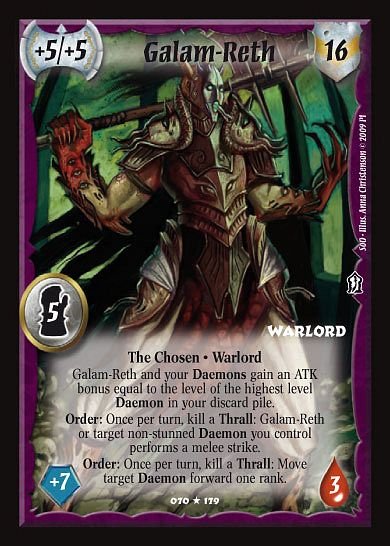
There are any number of ways to make this decision: if you have a particular faction, class and/or subclass you want to play, that will narrow the field quickly. Maybe you like a particular Warlord’s ability, or art, or flavor. If there’s a particular combo you want to use pick a Warlord who will help you set up that combination as quickly as possible, like King Xod or Kaimi Fateseeker for items, Allisara for characters, or Caitlyn the Free for actions.
Each faction and class has a number of different ways to play out the game. Ideally, you want all of the cards in your deck working synergistically towards that one goal. Some Warlords will buff their armies (particularly Clerics, Necromancers, Summoners, Bards and certain Fighters, like Sir Robert the Vigilant). Some Warlords will try to get in their opponents’ faces as quickly as possible (Rogue Assassins and Scouts, Front-line Fighters, and Spell Blitz Wizards). Some Warlords will build up to an unstoppable combo or power level (Combo Wizards or Rogues, Uber Fighters or Rogues). Other Warlords will try to choke their opponents out of the game (Seers, Druids, and Illusionists). Any Warlord can play any of these styles, but each Warlord has their own strengths and weaknesses, which leads into…
Every faction has at least 2 Warlords per class, which means if you’ve got a certain deck archetype in mind, you’re always going to have at least 2 choices of who to lead your army. For a simple example, let’s consider two Nothrog Warlords, Ar’tek and Uthanak. Both are 5th level fighters with powerful melee strikes—where they differ are their abilities. Uthanak can move any of your characters forward or backward one rank once per turn, whereas Ar’tek can move himself forward any number of times per turn. This means Ar’tek can always reach the front rank on turn 1, making him a much better front rank blitzer than Uthanak. On the other hand, Uthanak can guarantee front-line access for power cards like Braalig, or repeatable 3rd rank Warlord shots for The Conflagration, making him a much better army commander than Ar’tek. When designing your deck, you want to play around your Warlord’s individual strengths, not just the strengths of your Warlord’s class and faction.
The question of how you’re going to win is closely entwined with another question: when are you going to win the game? In general, the earlier you want to win the game, the more strikes you need, and the quality of those strikes is less relevant. The later you plan on winning the game, the higher quality of attacks you need. For example, Iam Unsullied swinging four times at +4 on turn 1 is terrifying: Lord Winter swinging four times at +4 on turn 4 is not. To this end, your deck needs to contain the cards that will allow you to meet your win condition. If your Warlord needs to be in the front rank causing damage turn 1, you need enough movement to get them there reliably. This is easy to test: after you’ve built your deck draw practice hands, and if your Warlord can’t get to the front in just about all of them, add more movement. If your Warlord is going to hulk out on turn 4, make sure you have not only the cards that will allow them to do that, but the cards that will keep them alive until then. If your deck revolves around one perfect kill shot, make sure you can find the pieces you need as quickly as possible, with draw and search.
The 6 characters who make up your starting army are arguably the most important 6 cards in your deck, because they are the only 6 cards in your deck you are guaranteed to see every game. Warlord is all about managing randomness in die rolls and in card draw, and your starting army is the easiest way to do that. Your starting army are the cards that will allow you to kill your opponent as quickly as possible in a rush deck or to stall for as long as possible in a combo or uber deck. But in all things, balance is key. It’s hard to have a higher starting attack than Ac’vuk, but even your opponent’s d’Ilchant Keepers will stand a good chance of shutting him down before he gets to swing. Defiance may look rock solid, but if you can’t swing back with him, you may find your opponent’s front rank grows too quickly to keep up with. Perhaps most crucially, your starting army will determine what low-level actions you are able to run. Some of the most powerful actions in the game are level 1 or 2, like Reflect, From Dust to Dust, Veiled Passing and Hero’s Gambit. Your Warlord may not always be in position or able to spend to use them. Having guaranteed characters who can use these abilities lets you run 2 or 3 copies of these power cards in your deck without worry of a dead draw.
Your deck can be at most 50% one card type; since you typically want to keep your deck to the minimum of 50 cards, this means you’re looking at a maximum of 25 of any particular type. You need a very good reason to not run 25 characters: actions are one and done and items are contingent upon characters. Characters add strikes, protect your warlord, and supplement your pool of available actions until they are killed. But what should you look for when choosing your characters? Consider three things:
1) How does the character help your win condition?
2) Will I be able to play this character?
3) How long will it take for this character to help me?
How does the character help your win condition? A character should help you win the game. If I am trying to kill my opponent with a Medusan Lord’s Gambit from Adonis the Cozener, the ability to move my Deverenians from rank to rank without spending does not directly contribute to this—therefore I should avoid cards like Cardinal Scelus or Xaros the Mist. On the other hand, a character like Grigori the Spineless can spend to cast spells you might otherwise have to spend Adonis for, and can also protect your ranks from collapsing via his ability.
Will I be able to play this character? It’s always good to have a Blackwind in play, but it’s never good to have a Blackwind you can’t play taking up space in your hand. At the start of the game, you can always play level 1-4 characters. If you have characters higher level than that, you’ll need a reliable plan to make sure you can get them into play. As the game goes on, you may lose access to rank 4, or your ranks might narrow and restrict your ability to play level 2 or level 3 characters. Crucially, you’ll always be able to play a level 1.
How long does it take for this character to help me? Donovan Che’har is better than Durga in almost every way—more attacks, higher AC, more hit points. But Donovan is level 4, and Durga is level 1. That means Durga can theoretically make 2 strikes the turn she is played, whereas unless you have a lot of support, Donovan will only be able to make his strikes two turns later. If you’re playing a fast deck, you can’t afford to wait that long. A combo or uber deck can drop a Strength and he’ll stun up and sit there soaking wounds, and he’ll be doing everything you could ever want him to do, but if you play Jackals of Mourn, you run the risk of instantly losing a level 4 character to a Fiery Bolts. Having characters that won’t help you the turn they come into play is a risk not all decks can afford to take.
Just as with your characters, items and actions need to contribute to your win condition: generating strikes for rush decks, enabling your Warlord in Uber, one-shotting the enemy in Combo. When selecting items and actions, you need to balance between the amount they contribute to your win condition vs. your ability to play those cards reliably. One of the surest way to lose a game of Warlord is to have cards in your opening hand that you cannot play. Black Steel Dagger is an incredible Rogue weapon, but what happens when you see two in your opening hand? Is it worth playing with a four card hand to have a Black Steel Dagger? It might be, but it very much might not. Similarly with actions: Obliterate is a stupendously powerful Fighter card. But it is difficult to use two in one turn, especially if you don’t have a level 5 fighter in rank 1. There are ways you can play around these risks: by playing characters like Wanderetch that can also equip a Black Steel Dagger in a pinch, or starting Baqbou Umbala and Borgen Ferriss to make sure your Serif al-Havoc will be able to Obliterate turn 1. Having characters that can discard cards from your hand for an effect can also mitigate the dangers of dead draw.
The first turn frequently the most important turn of the game: rush decks will try to put themselves far enough ahead on turn 1 to guarantee their opponent cannot come back. Slower decks will need to set themselves up to fulfill their win conditions as quickly as possible. Thus you need to make sure that your deck is going to do what it needs to do on turn 1. Set out your starting army and draw test hands. Make note of which cards you’re glad to see and which ones aren’t that useful. How often does each appear? Consider taking out a copy or two of cards that are clogging up our hand. How often are you able to get to the front rank, or put out a dragon? What cards can you add to make that more consistent? Which cards can you remove that aren’t helping you accomplish that goal?
Now you’re ready to play! But the deck-building process is never over: every game you play is step 7 all over again, but more thorough, more detailed. Going back through your deck and making changes after a game can be every bit as satisfying as playing. This article focused primarily on process—if you’re interested in learning more about which specific cards are frequently put in decks, see Chris Vac’s excellent breakdown of the Ancients format. Skip around to your favorite faction or watch the whole thing, then get deck-building. Good luck and make war!
2022 was a dramatic year in online Warlord. From the first ever Strategic to a new wave of Nothrog dominance, from the craziness of Build-a-Warlord to tried-and-true classics like Campaign, we covered the depth and breadth of what Warlord: Saga of the Storm has to offer.
Congratulations to all of our tournament winners, and good luck in 2023!
January Strategic: Nothrog Win! Bubble, Icefall, Jackalofmourn, Oeagle, Rollo, Slyfox, Wod,
February Class in Session: Oeagle with Cleric Seer Sargok
March Ancients: Graham with Ginerva of the Moon
April Build-a-Warlord: ChrisVac with Vak’ar’r’ko’ko, Nothrog Seer
May Good, Bad, and Ugly: WOD with Contal, Fo’ttr’ak’ka, and Pinion
June Peasant: ChrisVac with Menhetiri
July Turncoat: RayneBlythewood with Nothrog Ginerva of the Moon
August Build-a-Warlord: Midge with FatTok, Nothrog Necromancer
September Worlds: Celtic with Fo’ttr’ak’ka
October Campaign: Temperance with Captain Dukat
November Jautya Syne: Temperance with R’Veeka
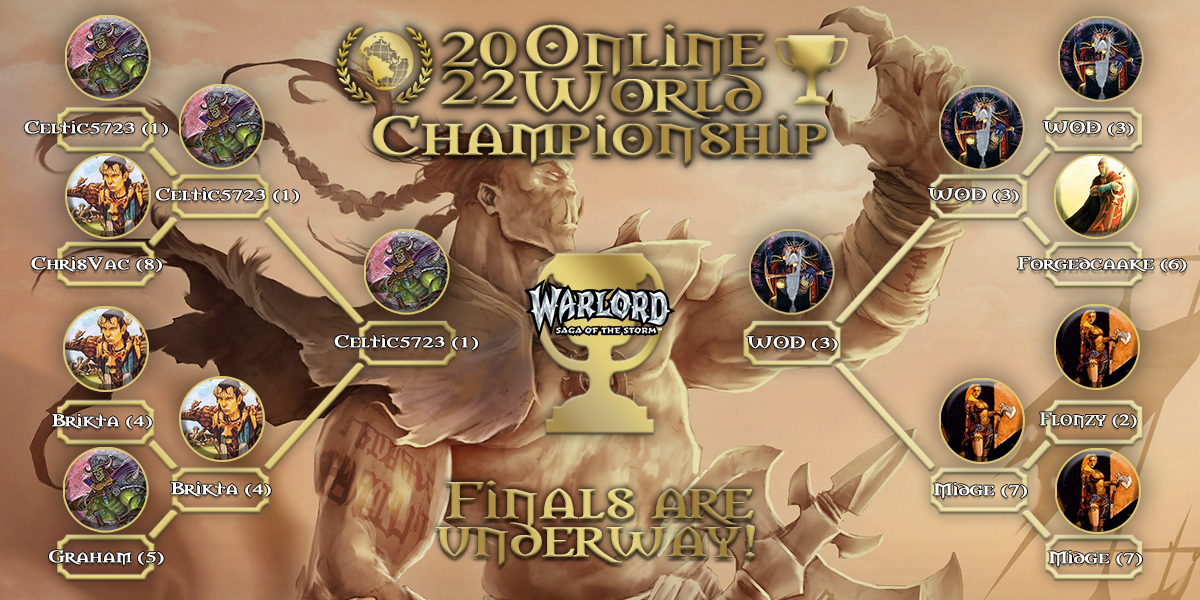
Celtic did what he’d been threatening to do since Quality of Life Ancients 2021 and took down our biggest tournament of the year, Online Worlds, with Fo’ttr’ak’ka. Nothrog had been winless up through November of 2021, and Celtic was at the forefront of the 2022 Throgaissance.
Nothrog won 7 out of the 11 events, Mercenaries won 2, Free Kingdoms and Deverenians won 1 each, and Dwarves were carried to a technical win in GBU by Nothrogs. Elves were shut out.
Of the 9 events with individual winning Warlords, 6 were won by Clerics, all but 2 of whom were Seers. Necromancers took 2, and our lone Rogue Scout took 1. Fighters were shut out of online play, though Lord Winter and Kothkah both took down in-person events.
ChrisVac and Temperance led the way in tournament wins, with 2 apiece.
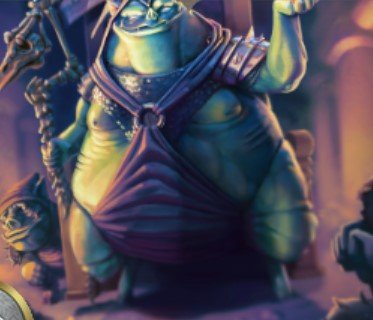
On the leaderboard, Midge (240) dominated the year, winning BAW 2 and making the finals in BAW 1, Jautya Syne and Campaign, the semi-finals in Classy, GBU, Peasant and Worlds and quarter-finals in March Ancients. The only tournament Midge didn’t make the cut in was Turncoat–truly an incredible performance.
WOD (217) narrowly edged out Graham (215) for 2nd, with a series of strong performances: winning GBU, placing 2nd at Worlds, making the semis in Turncoat and BAW 2, and quarters in Syne
Graham (215), Celtic (210), Rayne Blythewood (209), ChrisVac (195), Temperance (194), Oeagle (191), Slyfox (173) and Sangington (158) rounded out the top 10.
2022 was a wild year chock full of alternate formats and wholesale madness like Strategic and Two-Headed Highlander Open Multiplayer. In 2023, we’ll be going back to basics to celebrate our marquee format: Ancients. With it’s gigantic card pool and evolving meta, Ancients deserves more than 2 tournaments a year, and this year it will get at least 5. That’s not to say we don’t want to keep things fun: we’ll alternate Ancients with some alternate formats, and we’ve introduced Achievements to spice up Ancients deck building for those who are interested.
One of our goals in 2023 is to make sure the Online Circuit provides everyone with a way to engage—frequent Ancients tournaments will lower the barrier of entry for new players; Achievements will allow the deck building fiends to get experimental, and a faction-by-faction leader board will make it easier for those who want compete for top slots to do so. So get out there and play some Warlord!
Warlord Saga of the Storm in all forms is © and ™ Alderac Entertainment Group which has no affiliation with Guardians of the Storm.